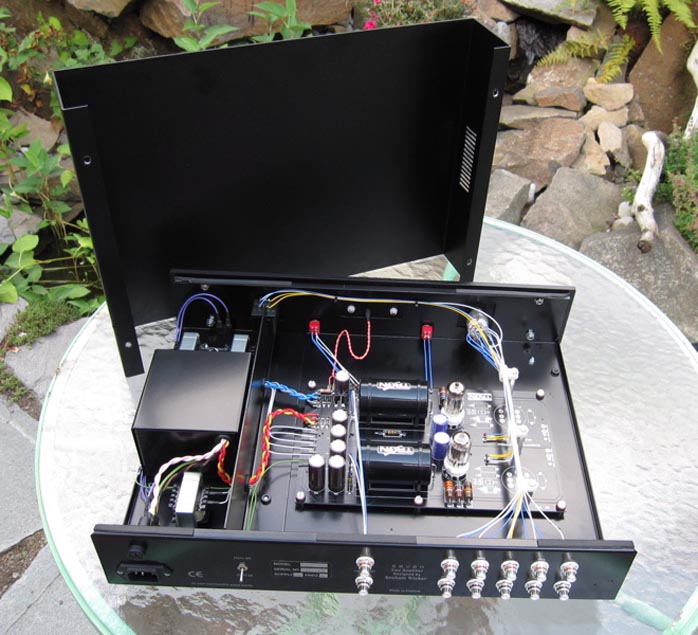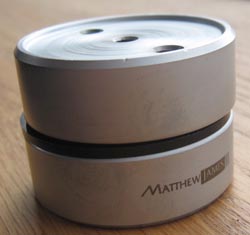This review page is supported in part by the sponsors whose ad banners are displayed below |
 |
 |
|
 |
Reviewer: Stephen Marsh
Financial Interests: click here
Digital Source: Vecteur D-2 CD Transport, Audio Note DAC Kit 1.2 with upgrades (ps choke, tantalum resistors, Black Gate caps, copper grounding bars on digital chips wired to central ground, VTV silver foil/oil output coupling caps)
Analog Source: Nottingham Analogue Mentor turntable with 10” Anna tonearm, Cardas Heart Reference, Goldbug Ms. Brier MC cartridges, both rebuilt by Soundsmith
Preamps: Hovland HP-100 MC tube preamplifier, Gill Audio Alana [on loan]), Slagle autoformer passive pre, Cello Audio Suite
Power Amps: Tron 211 SET amp with upgraded exotic-core interstage transformers (General Electric 211 power tubes, Western Electric 417A/5842 input tubes, RCA black plate 5U4GB rectifiers), Red Rose Model 2A Silver Signature tube amplifier (Mullard xf1 EL34 power tubes, RCA black plate 12AT7WA gain/inverter tubes and Tung Sol black plate 12AT7 driver tubes), DIY HiFi Supply Lady Day 300B amps with many upgrade options, Cello Performance amps
Speakers: WLM LaScala floorstanders, Bastanis Prometheus Mk. II with Gemini tweeters
Interconnect cables: Music Metre Fidelis digital, Harmony Audio, Cardas Golden Cross, Acoustic Systems Liveline, Bastanis Epilog I, Bastanis Heartbeat
Power Cords: Bastanis Epilog II, PS Audio Mini Lab (preamp), WSS [on loan], Acoustic Systems Liveline [on loan], Tel Wire [on loan]
Speaker Cables: Bastanis Epilog Mk. II, Bastanis Meta, Acoustic Systems Liveline
Equipment Racks: Adona 6-shelf low profile isolation rack, vintage modern teak for upstairs system (purchased at estate sale)
Power Line Conditioning: PS Audio P300 downstairs, none upstairs
Room Size: 29’ long x 16’ wide x 10’ high (sunken living room with open floor plan, listening across width of room.
Review Component Retail Price: $4,000
|
 |
Graham Tricker is a one-man operation building Tron tube electronics in Buckinghamshire, England. I first became aware of the Tron brand/marquee at CES 2004 where then importer Hart Hutchens of Audio Advancements was demonstrating the Tron Meteor phono and line stages along with the Tron push-pull 807 monoblocks (see Srajan’s show report). Having owned and loved a pair of VTL 120 monoblocks in the early 1990s, I was a fan of the 807 tube and intrigued to see a Brit employing this largely ignored but excellent sounding WWII surplus transmitter bottle. I also knew that Hart Hutchens had a knack for ferreting out unique very high-quality products from Europe.
The current Tron importer is Jeffrey Catalano of Highwater Sound Each Tron component is assembled, tested, listened to and packed by the designer,Graham Tricker. As a very satisfied owner of the Tron 211 SET amp, I was naturally interested in trying a matching Tron preamp. My Tron 211 is an older version but was updated to near current specification by Graham who also installed the optional exotic-core interstage transformers. Unlike many of the larger manufacturers, Graham believes in taking care of his customers and their equipment. My Tron 211 is a wonderful amp with very good dynamics, refinement and great soundstaging. I consider it a world-class amplifier. Since Tron’s top-of-the-line Syren preamp had already been reviewed by Edward Barker, I agreed to Graham’s offer to review the more affordable Tron Seven line stage preamp.
|
|
|
The Tron Seven arrived in a purpose-built heavy-duty cardboard box with ample protection. A two-page 'owner’s manual' was supplied, one page with introductory information and the other with operating instructions.

There is a mains/power switch on the front right underside of the preamp. The rear panel has five pairs of silver-plated RCA input jacks and one pair of RCA output jacks. There is also a ground lift switch on the rear to combat a possible ground loop. The faceplate has two chunky machined aluminum knobs on each side, one for input selection, one for volume. There are also two toggle switches on the front, one for mono/stereo and one for muting.
I opened up the preamp and admired the clean and beautifully laid-out circuitry. The workmanship is akin to artistry. 14dB gain is derived from a pair of Philips-branded 5687s located in ceramic sockets toward the right end of the circuit board. The extreme right of the board is unpopulated as this board serves double duty in a Tron DAC. As is common in most high-end preamplifiers, the circuit board is mechanically decoupled from the chassis. The AC portion of the power supply is shielded from the audio circuitry in a separate compartment to the left of the circuit board. An additional metal enclosure shields the power transformer. Solid-state rectification, regulation and capacitive filtering are located on the left end of the circuit board. Graham chose 2-watt carbon composition resistors for the 5687 tubes. His coupling caps are made to Tron specs and film/foil types. All internal wiring is silver-plated oxygen-free copper with PTFE insulation. A high-quality Noble volume control and an Elma selector switch round out the parts list.
 |
 |
The chassis of the Tron arrived seemingly warped in that its four feet did not sit squarely on my Adona rack platform*. The chassis is a basic folded aluminum box employing two U-shaped pieces with a lip that screws them together. Thinking that the Seven might be at a disadvantage due to incomplete mechanical grounding to the rack, I got out some Mathew James Footers (Mathew James now manufactures product descendants of Cello). These are bearing isolation devices that look very similar to the Aurios Classic Footers. I inserted three of them under the Tron, placing the one in the rear closer to the heavier power supply side.
My initial listening and breaking in of the Tron Seven line stage was done with the German WSS power cord supplied by Jeffrey Catalano of Highwater Sound, the US importer for Tron. I kept this power cord in place when I conducted my initial comparisons of the Tron Seven to my Hovland HP-100.
____________________
*As it turned out, the Tron sat squarely on my floor without wobble, leading me to determine that it was my rack shelf which was warped.
|
|
|
|
|
 |
|
 |
|